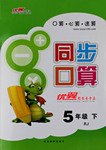题目内容
song Jay Zhou sings will surely become popular pretty soon.
A.What B.Which C.Whoever D.Whatever

 优翼小帮手同步口算系列答案
优翼小帮手同步口算系列答案My job was to make classroom observations and encourage a training program that would enable students to feel good about themselves and take charge of their lives. Donna was one of the volunteer teachers who participated in this 36 .
One day, I entered Donna’s classroom, took a seat in the back of the room and 37 . All the students were working 38 a task. The student next to me was filling her page with “I Can’ts.” “I can’t kick the soccer ball.” “I can’t get Debbie to like me.” Her page was half full and she showed no 39 of stopping. I walked down the row and found 40 was writing sentences, describing things they couldn’t do.
By this time the activity aroused my 41 , so I decided to check with the teacher to see what was going on 42 I noticed she too was busy writing. “I can’t get John’s mother to come for a parents’ meeting.” …… I felt it best not to 43 .
After another ten minutes, the students were 44 to fold the papers in half and bring them to the front. They placed their “I Can’t” statements into an empty shoe box. Then Donna
45 hers. She put the lid on the box, tucked it under her arm and headed out the door. Students followed the teacher. I followed the students. Halfway down the hallway Donna got a shovel from the tool house, and then marched the students to the farthest corner of the playground. There they began to 46 . The box of “I Can’ts” was placed at the 47 of the hole and then quickly covered with dirt. At this point Donna announced, “Boys and girls, please join hands and 48 your heads.” They quickly formed a circle around the grave.
Donna delivered the eulogy (悼词). “Friends, we gathered here today to 49 the memory of ‘I Can’t.’ He is 50 by his brothers and sisters ‘I Can’ and ‘I Will’. May ‘I Can’t’ rest in51 . Amen!”
She turned the students 52 and marched them back into the classroom. They celebrated the 53 of “I Can’t”. Donna cut a large tombstone from paper. She wrote the words “I Can’t” at the top and the date at the bottom, then hung it in the classroom. On those rare occasions when a student 54 and said, “I Can’t,” Donna 55 pointed to the paper tombstone. The student then remembered that “I Can’t” was dead and chose other statement.
36. A. job | B. project | C. observation | D. course |
37. A. checked | B. noticed | C. watched | D. waited |
38. A. on | B. with | C. as | D. for |
39. A. scenes | B. senses | C. marks | D. signs |
40. A. nobody | B. somebody | C. everyone | D. anyone |
41. A. curiosity | B. suspect | C. sympathy | D. worry |
42. A. and | B. or | C. but | D. so |
43. A. insert | B. interrupt | C. talk | D. request |
44. A. taught | B. shown | C. forced | D. instructed |
45. A. added | B. wrote | C. made | D. folded |
46. A. cry | B. pray | C. dig | D. play |
47. A. back | B. bottom | C. top | D. edge |
48. A. drop | B. raise | C. fall | D. lift |
49. A. keep | B. thank | C. forgive | D. honor |
50. A. remembered | B. punished | C. removed | D. replaced |
51. A. silence | B. heart | C. peace | D. memory |
52. A. down | B. up | C. off | D. around |
53. A. birth | B. passing | C. loss | D. starting |
54. A. awoke | B. reminded | C. forgot | D. apologized |
55. A. simply | B. hardly | C. seriously | D. angrily |
